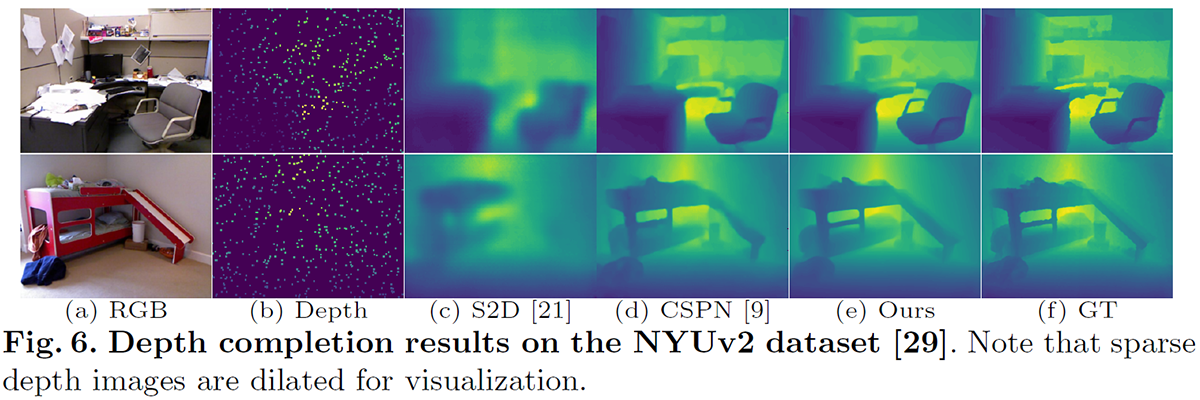Jinsun Park, Kyungdon Joo, Zhe Hu, Chi-Kuei Liu and In So Kweon
-
Jan. 2021 : Confidence issue fixed. Please refer to #16 for the details.
-
Dec. 2020 : Winner, Qualcomm Innovation Fellowship Korea (QIFK) 2020
-
Oct. 2020 : Pretrained models are released. Please refer to here.
In this paper, we propose a robust and efficient end-to-end non-local spatial propagation network for depth completion. The proposed network takes RGB and sparse depth images as inputs and estimates non-local neighbors and their affinities of each pixel, as well as an initial depth map with pixel-wise confidences. The initial depth prediction is then iteratively refined by its confidence and non-local spatial propagation procedure based on the predicted non-local neighbors and corresponding affinities. Unlike previous algorithms that utilize fixed-local neighbors, the proposed algorithm effectively avoids irrelevant local neighbors and concentrates on relevant non-local neighbors during propagation. In addition, we introduce a learnable affinity normalization to better learn the affinity combinations compared to conventional methods. The proposed algorithm is inherently robust to the mixed-depth problem on depth boundaries, which is one of the major issues for existing depth estimation/completion algorithms. Experimental results on indoor and outdoor datasets demonstrate that the proposed algorithm is superior to conventional algorithms in terms of depth completion accuracy and robustness to the mixed-depth problem. Our implementation is publicly available on the project page.
Our paper is available in ECCV 2020 Proceedings or arXiv.
@inproceedings{park2020non,
title={Non-Local Spatial Propagation Network for Depth Completion},
author={Park, Jinsun and Joo, Kyungdon and Hu, Zhe and Liu, Chi-Kuei and Kweon, In So},
booktitle={Proc. of European Conference on Computer Vision (ECCV)},
year={2020}
}
Our released implementation is tested on:
- Ubuntu 16.04 / Ubuntu 18.04
- Python 3.8 (Anaconda 4.8.4)
- PyTorch 1.6 / torchvision 0.7
- Tensorboard 2.3
- NVIDIA CUDA 10.2
- NVIDIA Apex
- Deformable Convolution V2
- 4x NVIDIA GTX 1080 TI / 4x NVIDIA Titan RTX GPUs
We used NVIDIA Apex (commit @ 4ef930c1c884fdca5f472ab2ce7cb9b505d26c1a) for multi-GPU training.
Apex can be installed as follows:
$ cd PATH_TO_INSTALL
$ git clone https://github.com/NVIDIA/apex
$ cd apex
$ git reset --hard 4ef930c1c884fdca5f472ab2ce7cb9b505d26c1a
$ pip install -v --no-cache-dir --global-option="--cpp_ext" --global-option="--cuda_ext" ./ Build and install DCN module.
$ cd NLSPN_ROOT/src/model/deformconv
$ sh make.shThe DCN module in this repository is from here but some function names are slightly different.
Please refer to the PyTorch DCN for the original implementation.
We used two datasets for training and evaluation.
We used preprocessed NYUv2 HDF5 dataset provided by Fangchang Ma.
$ cd PATH_TO_DOWNLOAD
$ wget https://datasets.lids.mit.edu/sparse-to-dense/data/nyudepthv2.tar.gz
$ tar -xvf nyudepthv2.tar.gzAfter that, you will get a data structure as follows:
nyudepthv2
├── train
│ ├── basement_0001a
│ │ ├── 00001.h5
│ │ └── ...
│ ├── basement_0001b
│ │ ├── 00001.h5
│ │ └── ...
│ └── ...
└── val
└── official
├── 00001.h5
└── ...
Note that the original full NYUv2 dataset is available at the official website.
After preparing the dataset, you should generate a json file containing paths to individual images.
$ cd NLSPN_ROOT/utils
$ python generate_json_NYUDepthV2.py --path_root PATH_TO_NYUv2Note that data lists for NYUv2 are borrowed from the CSPN repository.
KITTI DC dataset is available at the KITTI DC Website.
For color images, KITTI Raw dataset is also needed, which is available at the KITTI Raw Website.
Please follow the official instructions (cf., devkit/readme.txt in each dataset) for preparation.
After downloading datasets, you should first copy color images, poses, and calibrations from the KITTI Raw to the KITTI DC dataset.
$ cd NLSPN_ROOT/utils
$ python prepare_KITTI_DC.py --path_root_dc PATH_TO_KITTI_DC --path_root_raw PATH_TO_KITTI_RAWAfter that, you will get a data structure as follows:
.
├── depth_selection
│ ├── test_depth_completion_anonymous
│ │ ├── image
│ │ ├── intrinsics
│ │ └── velodyne_raw
│ ├── test_depth_prediction_anonymous
│ │ ├── image
│ │ └── intrinsics
│ └── val_selection_cropped
│ ├── groundtruth_depth
│ ├── image
│ ├── intrinsics
│ └── velodyne_raw
├── train
│ ├── 2011_09_26_drive_0001_sync
│ │ ├── image_02
│ │ │ └── data
│ │ ├── image_03
│ │ │ └── data
│ │ ├── oxts
│ │ │ └── data
│ │ └── proj_depth
│ │ ├── groundtruth
│ │ └── velodyne_raw
│ └── ...
└── val
├── 2011_09_26_drive_0002_sync
└── ...
After preparing the dataset, you should generate a json file containing paths to individual images.
$ cd NLSPN_ROOT/utils
# For Train / Validation
$ python generate_json_KITTI_DC.py --path_root PATH_TO_KITTI_DC
# For Online Evaluation Data
$ python generate_json_KITTI_DC.py --path_root PATH_TO_KITTI_DC --name_out kitti_dc_test.json --test_data


